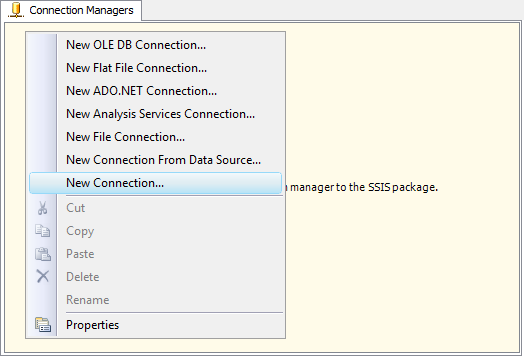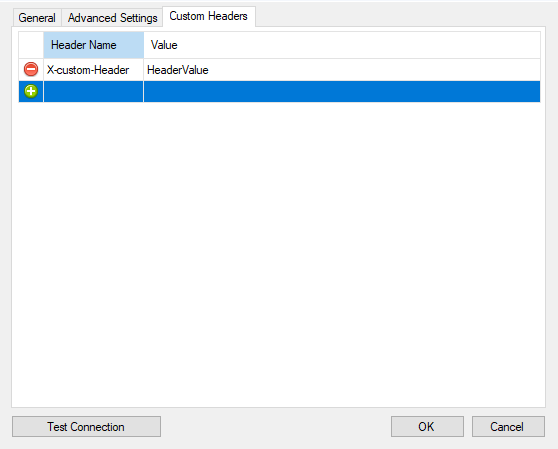Setup a REST Zoho Expense Connection Manager
The REST Connection Manager is an SSIS connection manager component that can be used to establish connections with Zoho Expense REST service to help facilitate data integration for Zoho Expense.
See Zoho Expense REST Source Component for how to retrieve data from Zoho Expense and Zoho Expense REST Destination Component for how to write to Zoho Expense.
To add a new connection, right-click the Connection Manager area in your Visual Studio project, and choose "New Connection..." from the context menu. You will be prompted the "Add SSIS Connection Manager" window. Select the "REST (KingswaySoft)" item to add a new REST Connection Manager.


The REST Connection Manager contains 2 pages of configuration.
- General
- Advanced Settings
General Page
The General page allows you to specify connection properties and login credentials for Zoho Expense REST service:

- Base URL
-
The Base URL of the Zoho Expense instance that will be connected to.
- API Throttle Rate
-
The API Throttling Rate will limit the number of requests that can be sent per second.
- Authentication
-
- Generate Token File…
-
This button allows you to login to the service endpoint and authorize your app to generate a token.

- App Type
-
The App which will be used to connect to your Zoho Expense instances. Available options are:
- KingswaySoft: The Connection Manager will use the Client Id and Secret that is provided by KingswaySoft for your convenience when setting up the connection, it should NEVER be used for production purpose.
- My Own App: Selecting this option will allow you to use your own Client ID and Secret to connect to Zoho Expense instances.
- App Info
-
Here you can enter the Client ID and Client Secret which you would be getting from OAuth setup at the API side. The Redirect URL would be the one that you had specified in the App settings. You may set the Scope you want to give the connection.
- Data Center
-
Select the Data Center that is applicable for your instance from the list. There are four options available:
- United States
- Europe
- India
- Australia
- Use Default Browser to Sign In
-
When this option is checked the Sign In and Authorize button will open your default web browser to complete the OAuth authentication. When this option is unchecked, the Sign In and Authorize button will complete the entire OAuth authentication process inside of the toolkit.
- Sign In and Authorize
-
This button allows you to login to the service endpoint and authorize your app to generate a token.
- Path To Token File
-
The path to the token file on the file system. Please note that this field supports both file system path as well as Azure Blob Storage Shared Access Signature (SAS) URL path.
Note: The component supports Azure Blob Shared Access Signature (SAS) URL in the token file path.
- Token File Password
-
The password to the token file.
- Organization Id
-
Once the token is generated, choose the Organization Id generated from the list.
- Test Connection
-
After all the connection information has been provided, you may click the "Test Connection" button to test if the user credentials entered can connect to the selected REST service.
Advanced Settings Page

- Proxy Mode
-
Proxy Mode option allows to specify how you want to configure the proxy server setting. There are three options available.
- No Proxy
- Auto-detect (Using system configured proxy)
- Manual
- Proxy Server
-
Using Proxy Server option allows you to specify the name of the proxy server for the connection.
- Port
-
The Port option allows you to specify the port number of the proxy server for the connection.
- Username (Proxy Server Authentication)
-
Username option (under Proxy Server Authentication) allows you to specify the proxy user account.
- Password (Proxy Server Authentication)
-
Password option (under Proxy Server Authentication) allows you to specify the proxy user's password.
Note: The Proxy Password is not included in the connection manager's ConnectionString property by default. This is by design for security reasons. However, you can include it in your ConnectionString if you want to parameterize your connection manager. The format would be ProxyPassword=myProxyPassword; (make sure you have a semicolon as the last character). It can be anywhere in the ConnectionString.
- Timeout
-
The number of seconds requests should wait before timing out.
-
- Retry on Intermittent Errors
-
The retry on intermittent errors option determines if requests will be retried when there is an error. If this option is checked requests will be retried up to 3 times.
- Ignore Certificate Errors
- This option can be used to ignore those SSL certificate errors when connecting to Zoho Expense servers.
Warning: Enabling the "Ignore Certificate Errors" option is generally NOT recommended, particularly for production instances. Unless there is a strong reason to believe the connection is secure - such as the network communication is only happening in an internal infrastructure, this option should be unchecked for best security.
Custom Headers Page

The Custom Headers page will allow you to set the Header Name and Header Value. You may select the green icon to add another row, and the red icon to remove an existing header you have configured.

